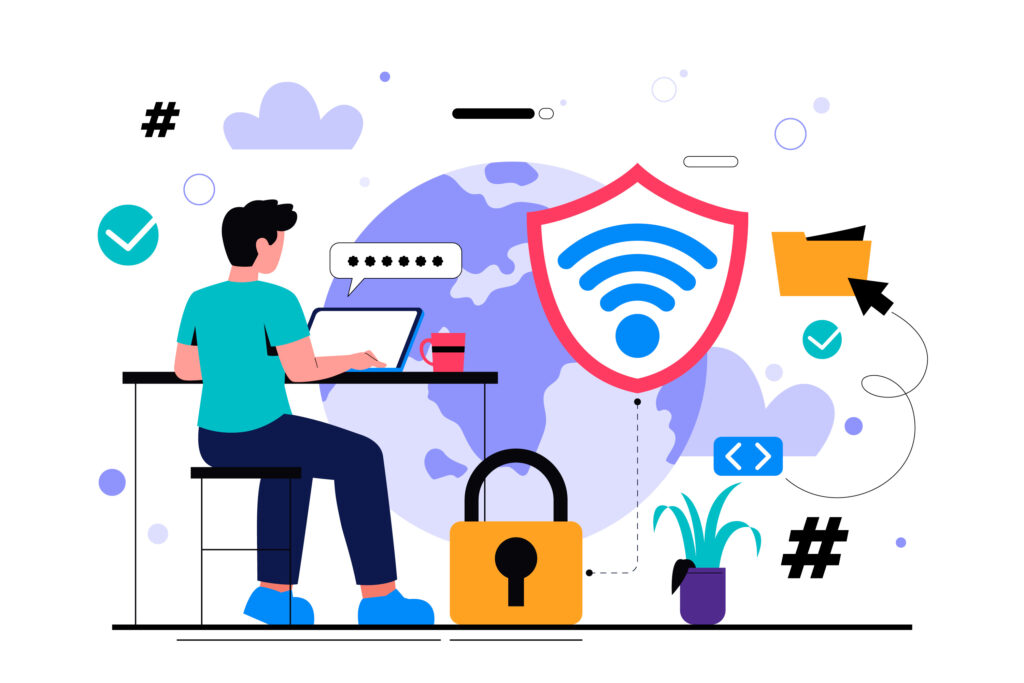Strategies to Safeguard Your Organization
For an organization that is active at a moment when digital threats are constantly evolving, it is more important than ever to focus on security. Cyber risks are a real and present danger for enterprises in many areas of the economy — they can take many different forms, after all, from sophisticated phishing scams to highly targeted malware.
At the heart of any organization is, of course, its workforce. Alongside leading technology, however, they possess the know-how to stand as a bastion against those threats. This comprehensive guide shines a light on the best ways to shore up your enterprise’s cyber defenses, and, in the process it details why the importance of employee training, the value of a robustly cyber security training PowerPoint, and the power of platforms such as Quickboarding should never be underestimated in this kind of endeavor.
Understanding the Current Cyber Threat Landscape
Cyber dangers are always changing, and the digital terrain is a battlefield. New vulnerabilities are found and sophisticated cyberattacks are performed every day. These dangers include ransomware, which has the ability to shut down important systems and extort large ransom payments, and social engineering schemes that trick staff members into disclosing private information. There is a lot on the line with these attacks; even one that is successful can result in compromised sensitive data, lost money, and damaged reputation.
Creating a defence plan that works requires first understanding this terrain. It’s important to comprehend not just the different kinds of risks but also how they might affect your company. This information serves as the cornerstone of any effective cyber security programme and directs the focus of staff development and resource allocation.
The Role of Employee Training in Cyber Security
In the chain of cyber security, people are frequently the weakest link. Depending on their level of training, employees may be your best ally or your worst enemy. Frequent and thorough training may turn workers from possible security risks into knowledgeable protectors of the company’s digital assets.
There should be more included in a well-designed training programme than just the fundamentals of cyber security. It must include things like the most recent trends in threats, safe internet usage, the value of strong passwords, how to spot phishing efforts, and what to do next when a danger is discovered. In addition to providing information, the objective is to instill a culture of cyber security awareness at every organisational level.

Comprehensive Cyber Security Training for Employees
Employee cyber security training is a continuous process rather than a one-time thing. The world of digital threats is ever-changing, and training programmes must also be flexible. To maintain the training current and useful, regular updates and refreshers are essential.
The Importance of Regular Training Sessions
Rapid evolution of cyber dangers means that a training programme that was successful a year ago may not be relevant today. Frequent training sessions guarantee that staff members comprehend the most recent cyber defence best practices in addition to being knowledgeable of the newest hazards. All personnel, regardless of position within the company, should be required to attend these sessions, which have to be planned on a regular basis.
Frequent training also helps employees remember the value of cyber security by reinforcing it. Employee awareness of cyber security is insufficient; they also need to realise that it’s a crucial component of their duties. This ongoing focus contributes to the development of a robust, security-aware workplace culture.
Utilizing Engaging and Interactive Training Methods
The degree of engagement a training programme has is a major factor in its efficacy. While lengthy, boring lectures are likely to be forgotten, lively, participatory workshops can have a lasting impression. Interactive training techniques may greatly improve the learning process. Examples of these techniques include scenario-based exercises, gamified learning, and hands-on workshops.
For example, gamified learning employs game-playing features like point scoring, rivalry with other players, and rules of play to promote interaction with the training content. Employees participating in scenario-based exercises, on the other hand, are put in simulated scenarios where they must use their expertise to solve issues in the real world. These techniques increase the relatability and retention of cyber security knowledge.
Identifying and Preventing Phishing Attacks
Phishing is one of the most common cyberthreats that businesses encounter nowadays. Phishing attacks entail deceiving people into downloading malware or disclosing confidential information by seeming to be a reliable source in online communications. Any cyber security policy must include personnel training on how to recognise and avoid phishing attempts.
Teaching Employees to Recognize Phishing Attempts
The sophistication of phishing efforts has increased, making it more difficult to detect them. Telltale indicators can nevertheless, however, warn a watchful employee. The main goals of training should be to teach staff members how to notice phishing emails, identify suspect email addresses, identify phoney URLs, and recognise strange requests or attachments.
Additionally, the training ought to stress how crucial it is to confirm the legitimacy of requests for private information, particularly when they originate from unexpected sources. Workers should be instructed to contact the purported sender via an alternative, authenticated route to confirm the authenticity of such requests.

Steps to Take When a Phishing Attempt is Detected
Acknowledging a phishing effort is just half the fight; staff members also need to know what to do if they come across one. This entails not replying to the email, not opening any attachments or clicking on any links, and notifying the company’s IT or cyber security personnel about the effort.
The company should have straightforward reporting procedures in place for any suspected phishing efforts. All staff members should be informed about these protocols, and they ought to be covered in the standard training curriculum. In addition to utilising the data to strengthen the organization’s overall cyber defences, prompt reporting can assist the IT staff in taking the required steps to stop the phishing effort from inflicting any harm.
PhishGrid & Quickboarding – Game changing solutions
In addition to free resources, platforms like Quickboarding & PhishGrid play a pivotal role in enhancing cyber security phishing simulation & training. Quickboarding in partnership with PhishGrid offers a comprehensive suite of training resources tailored to various aspects of cyber security.
PhishGrid – Epitome of Phishing simulation
It provides various platforms like phishing simulation platform, services, attack templates etc. Its innovative platform transforms phishing defense into an engaging, empowering experience. You can measure all your anti-phishing activities with their online reporting engine.

Quickboarding’s Treasure Trove of Resources
Quickboarding distinguishes itself with its extensive content library, which includes interactive modules, videos, quizzes, and real-life case studies. These resources are designed to cater to different learning styles, ensuring that every employee finds a module that resonates with them. The platform’s content is regularly updated, ensuring that it remains relevant in the ever-evolving landscape of cyber threats.
Therefore Quickboarding in partnership with PhishGrid has developed a seamless solution to provide phishing simulation as well as cyber security for training anyone who is vulnerable to the virtual dangers in your organization.
Cultivating a Security-Minded Culture
Creating a culture of cyber security awareness within an organization goes beyond just training. It involves ingraining security-minded behaviours and attitudes into every aspect of the business.
Every Employee: A Cyber Warrior
Every employee needs to think of themselves as a custodian of the company’s digital assets in order to develop an effective cyber defence. This entails being aware of the vital role they play in safeguarding private data and exercising caution when doing ordinary business. Cybersecurity knowledge may be maintained by frequent conversations, updates, and reminders.
Keeping Up with Cyber Trends
The world of cyber security is constantly changing, with new threats and defences appearing on a regular basis. Organisations need to keep up with these advancements. This might entail encouraging staff members to take part in outside training programmes, attending webinars, and subscribing to cyber security newsletters. Remaining up to date facilitates organisations’ ability to modify their tactics in response to novel threats and capitalise on developing technology to improve security.

Hackers are waiting for a single mistake…..
Audit & Upgrade Your Training Program
A static training program is unlikely to be effective in the long term. Regular audits and updates are essential to ensure that the training remains relevant and effective.
Measuring Training Success
A training program’s effectiveness may be evaluated using a variety of criteria. These might include the quantity of phishing attempts that have been reported, the outcomes of cyberattack simulations, employee opinions, and test results from training courses. Frequent evaluations might reveal areas in which the training may be deficient and offer suggestions for enhancements.
Staying Ahead of Cyber Threats
Remaining ahead of cyber risks is the aim of the training program’s audits and updates. This entails foreseeing problems in the future in addition to responding to current risks. Training must to be updated often to reflect the most recent best practices in cyber security as well as knowledge on emerging risks. It’s vital to guarantee that the training programme adapts to advancements in technology and the IT infrastructure of the organisation.
Secure Today, Safer Tomorrow
It is crucial to take a proactive approach to cyber security as we negotiate the intricate web of online dangers. A safe organisation fosters a culture where every employee is informed and watchful, not only those with the appropriate tools and technology.
Key Takeaways for a Secure Future
Continuous learning and modification are necessary on the path to becoming a safe organisation. Important components include fostering a security-first mentality, keeping up with the most recent cyber developments, and providing frequent and interesting staff training. Using tools such as Quickboarding improves training and makes learning more efficient and pleasurable.
Embracing Proactive Security Measures
Anticipating possible dangers and taking action to neutralise them before they materialise are examples of proactive security measures. This entails conducting routine risk assessments, upgrading security procedures, and making certain that all staff members are properly educated to identify and address cyber threats. An organization that is proactive about its cyber security is not only better equipped to handle potential threats but also demonstrates a commitment to protecting its assets, employees, and customers.
FAQs
1. How often should we conduct cyber security training for employees?
Cyber security training should be an ongoing process. It’s recommended to conduct training sessions at least quarterly to keep up with the evolving threat landscape.
2. Can small businesses benefit from free cyber security training resources?
Absolutely. Free resources like the Cyber Security Training PPT are particularly valuable for small businesses to start or enhance their cyber security training programs.
3. What makes Quickboarding an effective platform for cyber security training?
A3: Quickboarding offers a comprehensive and dynamic suite of training resources, utilizing engaging and interactive content tailored to different learning styles, making it an effective tool for enhancing cyber security knowledge.
4. What are the key components of a successful cyber security training program?
A4: A successful training program should include regular updates, engaging and interactive content, real-world examples, and should cover a wide range of topics from basic cyber hygiene to advanced security measures.
5. How can organizations measure the success of their cyber security training?
A5: Success can be measured through various metrics such as the reduction in security incidents, employee feedback, results of simulated phishing tests, and overall improvement in security practices within the organization.
Free PPT: Your Go-To Cyber Security Training Resource
In an effort to support organizations in their quest for robust cyber security, we offer a valuable tool – a free Cyber Security Training PowerPoint (PPT). This resource is designed to aid organizations in conducting effective, in-house cyber security training sessions.
Fill out the below form to get your free PPT resource.

